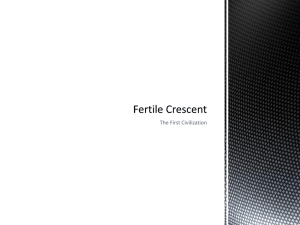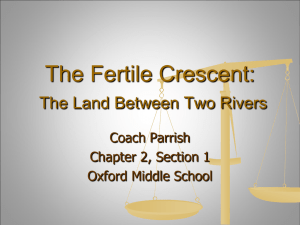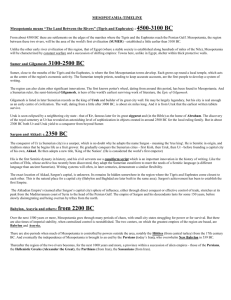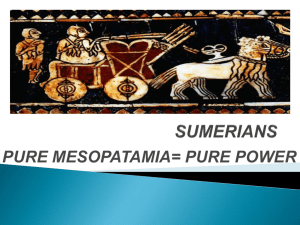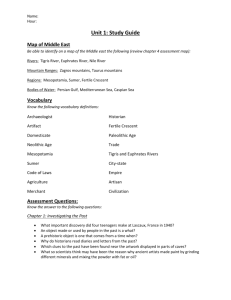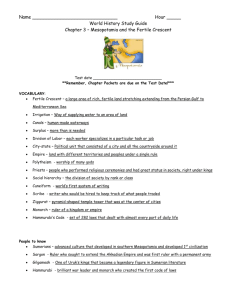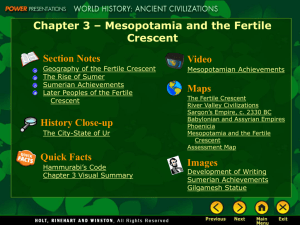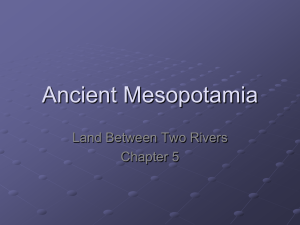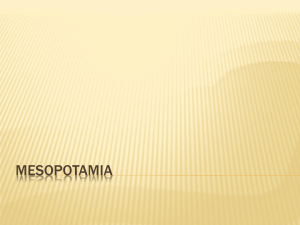II. - EVSC ICATS
advertisement
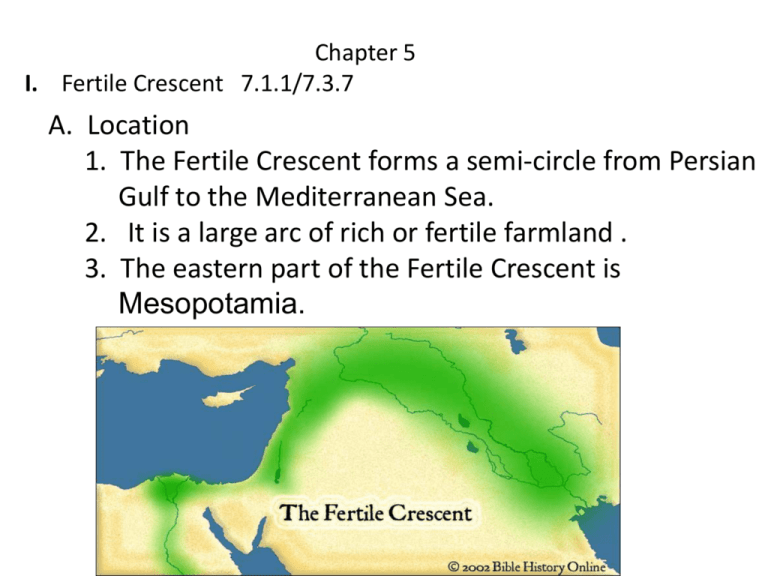
Chapter 5 I. Fertile Crescent 7.1.1/7.3.7 A. Location 1. The Fertile Crescent forms a semi-circle from Persian Gulf to the Mediterranean Sea. 2. It is a large arc of rich or fertile farmland . 3. The eastern part of the Fertile Crescent is Mesopotamia. B. The eastern part of the Fertile Crescent is called Mesopotamia. 1. Mesopotamia - “land between the rivers” 2. The two main rivers are the Tigris & Euphrates. 3. Mesopotamia was the world’s first civilization. . C. The yearly flooding of the rivers brought silt. 1. Silt made the land ideal for farming. 2. Silt- a mixture of rich soil and tiny rocks II. Farming & Cities 7.1.1/7.3.7/7.3.11 A. Mesopotamians had to learn to control flooding. 1. They used canals and irrigation ditches. 2. Canals are human-made waterways. B. Farmers used irrigation to supply water to an area of land. C. A better system of farming led to a surplus of food. 1. Mesopotamian foods - fish, meat, wheat, barley, and dates. 2. Surplus led to trade . Development of Cities 1. Fewer people had to farm 2. People were free to do other jobs 3. Division of labor-people specializing in a particular job. 4. People went from being huntergathers to living in villages (farmers) to forming cities with laws and government. Section 2: Rise of Sumer I. City –States 7.1.1/7.3.7/7.3.11 A. Most people in Sumer were farmers. 1. They lived in rural areas. 2. Rural means country. B. Cities 1. Centers of Sumerian society 2. Urban means city areas. II. Sumer A. Sumerians developed the first civilization in Sumer (around 3000 B.C.). B. City-States consisted of a city and the countryside around it. C. City-States fought each other to gain more farmland. D. The people built strong armies and walls around their cities. III. Rise of Akkadian Empire and Sargon 7.1.3/7.3.7/7.3.11 A. Capital city north of Sumer was Akkad. B. Spoke a different language C. Leader was Sargon IV. Sargon 7.1.3 A. First ruler with permanent army. 1. Used bows and arrows. B. Sargon established first empire. 1. Empire- land with different territories and peoples under a single rule Sargon’s Army V. Religion 7.1.1/ 7.3.11 A. Played a role in daily life B. Practiced polytheism -belief in many gods 1. Gods had powers 2. Priests had great status in Sumer Sumarian Ziggurat (Temple) 3. Largest building was ziggurat where people worshipped (step-pyramid shaped) VI. Society 7.1.1/ 7.3.11 A. In Sumerian society, people’s social class or rank depended on their wealth and their occupation (Job). Sumerian Social Hierarchy King Priests Craft people, Merchants, Traders Farmers Laborers Slaves (Could gain freedom after 3 years) VII. Role of Men and Women 7.1.1/ 7.3.11 A. Men 1. Men held political power and made laws. 2. Men received education B. Women 1. Women took care of home and kids. 2. Some upper class women were educated. 3. Some women were priestesses in Sumer’s temples. Section 3 7.1.3 I. Invention of writing A. Sumerians developed cuneiform, the world’s first system of writing. 1. Sumerians used sharp tools called styluses to make wedge-shaped symbols on clay tablets. 2. Earlier communication used pictographs (picture symbols). 3. Developed an alphabet (alphabet we use today is based on the Phoenician alphabet) a. It made writing easier b. Each letter represented a sound instead of a word or phrase. c. More people could learn to read and write. B. Scribes were writers hired to keep track of records. 1. 2. 3. 4. Most scribes were boys. Studied reading and writing in school. Epics- long poems that tell the stories of heroes Epic of Gilgamesh-story of a legendary Sumerian king II. Other inventions 7.1.3 A. First people to use the wheel 1. vehicles such as carts 2. horse drawn chariots 3. potter’s wheel B. Plows pulled by oxen broke the hard clay soil. C. Built sewers under city streets D. Developed math system based on 60 1. Divided circle into 360 degrees 2. Divided a year into 12 months 3. Calculated area of triangles and rectangles E. Sumerian Art 1. Architecture-science of building a. Kings- large palaces b. Rich- two-story homes c. Most people- One-story homes d. Clay bricks-made of mud e. Ziggurat- step pyramid-shaped temple 2. Art such as statues, pottery, and jewelry 3. Cylinder Seals with designs to sign documents Section 3 7.1.1/7.3.11 I. Rise of Babylon A. 1792 B.C. Hammurabi became Babylon’s king; he brought all of Mesopotamia under his control. B. Hammurabi’s Code 1. Set of 282 laws that dealt with most parts of daily life ---Written down for all to see 2. Carved laws on a stone column for everyone to see 3. Believed punishment should reflect the crime II. Assyrians 7.1.1/7.3.11 A. iron working/use of chariots fierce fighters B. Chaldeans: Nebuchadnessar- famous Chaldean king 1. Rebuilt Babylon and built Hanging Gardens of Babylon 2. Chaldeans charted position of stars, created a calendar, and solved geometry problems. complex Babylonian and Assyrian Empire III. Phoenicians 7.1.1/7.3.11 A. Present day Lebanon B. Purple dye made from shellfish (purple cloth used for royalty and rich) C. Had valuable CEDAR trees (great trade item) D. Developed an alphabet (alphabet we use today is based on the Phoenician alphabet)
